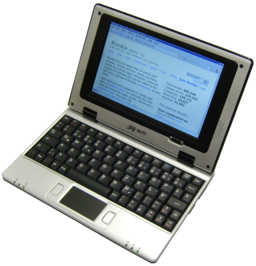Skytone Alpha-400

German version branded by JAY-tech
|
|
| Developer | Skytone, Exon International Technology Co Ltd |
|---|---|
| Manufacturer | Exon International Technology Co Ltd |
| Type | Netbook |
| Media | 1 or 2 GB NAND flash soldered on mainboard |
| Operating system | customized CE Linux kernel 2.4.20 or Windows CE 5.0 |
| CPU | Ingenic Jz4730 a.k.a. XBurst (32-bit, 336 MHz) |
| Memory | 128 MiB SDRAM |
| Display | matte 7 in 800×480 LED-backlit TFT LCD |
| Input | Keyboard, touchpad |
| Connectivity | 10/100 Mbit Ethernet, ZyDAS ZD1211B 802.11b/g wireless LAN, 3 USB 1.1 ports, 3-in-1 flash memory card reader (SD, SDHC, MMC) |
| Power | Li-ion 7.4 V, 2.1 Ah 2-cell battery, approximately 3–4 hours use |
| Dimensions | 210 mm (8.3 in) H 140 mm (5.5 in) W 32 mm (1.3 in) D |
| Weight | 0.65 kg (1.4 lb) |
The Skytone Alpha-400 is a Linux-based low-cost netbook with a 7 in 800×480 LCD screen. Its measurements (length×width×depth) are 210×140×32 mm and it weighs 0.65 kg. It is made in China by Skytone and Exon International Technology Co Ltd, with the former providing the GNU/Linux software and the latter producing the hardware. It uses a Chinese Ingenic Jz4730 336 MHz MIPSII-compatible one core 32-bit system-on-a-chip (SoC) with 128 MiB of SDRAM, and a 1–2 GB solid state drive.
The Skytone Alpha-400 was designed with low cost and child-friendliness in mind, some versions being sold for as little as $130 retail. There is an option to swap the standard theme with a children's theme. It also comes with applications geared toward children, and a Flash player to play animated children's songs. The Flash player is not built into the browser, so Flash-dependent sites such as YouTube will not work, but a standalone Flash player is available to run .swf files and can be used to play Flash based games, and such.
The Skytone Alpha is often marketed, sometimes in slightly altered form, under many different brand names.
Here is a (probably incomplete) list of variants;
The Skytone Alpha-400 uses a customized version of Linux, based on a 2.4.x kernel, with a user-friendly interface optimized for children.
The Linux desktop is implemented as Kiosk software, meaning that nothing the user can do can modify the available applications, and no new applications can be (easily) added or removed.
Browsing can be done through the use of the built in browser called Bon Echo, an Alpha release of Mozilla Firefox 2, using the built-in 10/100 BASE-T Ethernet port, or the integrated 802.11 Wireless LAN, but the browser does not support Flash, meaning that Flash intensive tools, such as YouTube, cannot be used. However, recently Exon, the original design manufacturer of most of these devices, announced full support for YouTube and most Flash enabled websites.
...
Wikipedia
